AFFILIATE MARKETING
17 Ways to Give Your Site a Boost in 2023

It seems everyone has gone nuts with the launch of ChatGPT.
And for good reason. It’s helping content creators:
- Write articles
- Develop software
- Learn faster
- And so much more
But can you use ChatGPT for updating content? And make it better?
You sure can.
In this post, I’ll show you 17 ways to transform underperforming content into something epic.
Let’s begin.
ChatGPT vs Jasper
Unlike Jasper, ChatGPT needs a lot of hand-holding. To produce decent results will depend on the prompts you come up with.
This post will help you develop your prompt engineering skills by sharing real-life examples.
However, if you want to save time, Jasper helps you bypass this learning curve.
Jasper boasts an extensive library of templates for creating and updating quality content with ease.
There’s far less guessing involved as Jasper guides you in the content generation process.
You can try Jasper here or read our full Jasper review for more details.
Update Content for Higher Conversions
Higher conversions mean you’ll get more email subscribers and more sales with less traffic.
And you can use AI-generated content to write more persuasive copy than the average copywriter.
Here are several ways you can do just that using ChatGPT.
1. Attention-Grabbing Headlines
Headlines need to grab the reader’s attention before they’ll even consider reading further.
ChatGPT is great at turning boring headlines into irresistible ones.
Here’s a prompt you can use, followed by your headline:
Give me 10 more headlines that are more compelling and attention-grabbing than this one:
Here are the results I got:
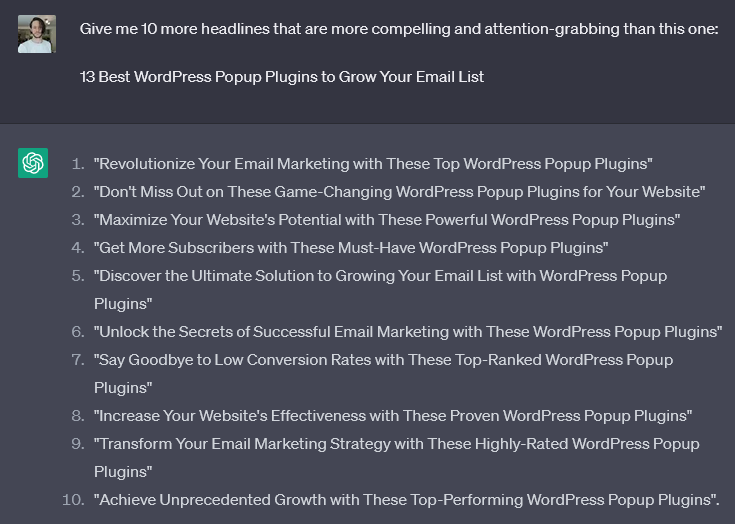
If you want to keep the main keyword at the front for SEO, then use this prompt instead:
Give me 10 more headlines that are more attention-grabbing than this one, whilst keeping “13 Best WordPress Popup Plugins” at the front:
The response?

The great thing about these is that it gives you so many ideas. You can choose different words from the different ideas it gives to make yours unique.
2. Crafting a Compelling Intro
After the headline, the introduction is the next most important piece of the content.
It also needs to keep readers engaged so they continue reading the post.
Here are some ChatGPT prompts to make improvements:
Write a concise and engaging intro for this article titled “Twitter Blue Is Now Mandatory For Running Ads On the Platform. How Does This Impact Brands?” that meets the search intent of the content:
I included the entire blog post after this prompt for the AI tool to analyze.
Here’s the original intro:
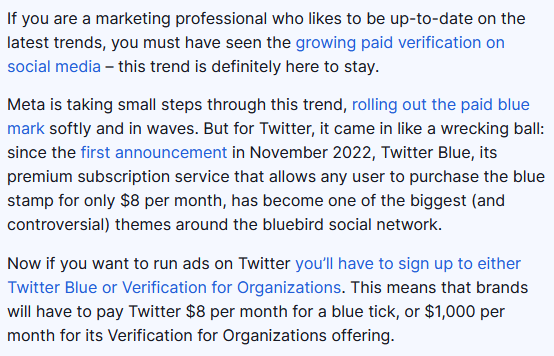
And here’s ChatGPT’s version:

Or you can ask ChatGPT to write in the style of other successful bloggers.
Prompt: Now rewrite the intro in the style of [blogger] from [website]
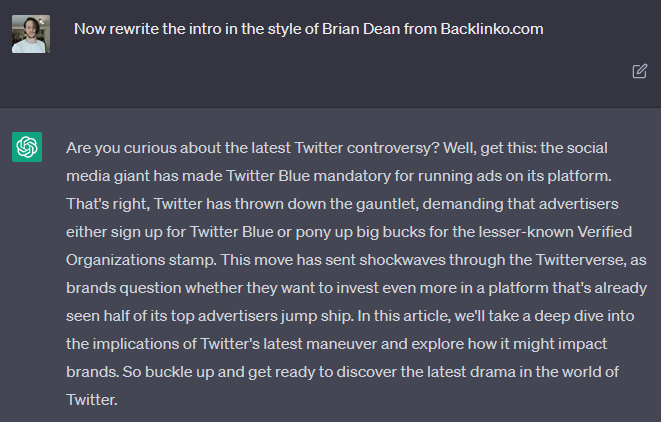
3. Implementing AIDA Formula
Want to collect more emails? Then try this.
Create a free content upgrade for your top-performing articles using ChatGPT.
Then ask ChatGPT to write the opt-in form copy using the AIDA formula.
First, ask for some content upgrade ideas with this prompt:
Give me 5 content upgrade ideas for this article:
Here are a few content upgrade ideas ChatGPT came up with for one of my previous Niche Pursuits posts:
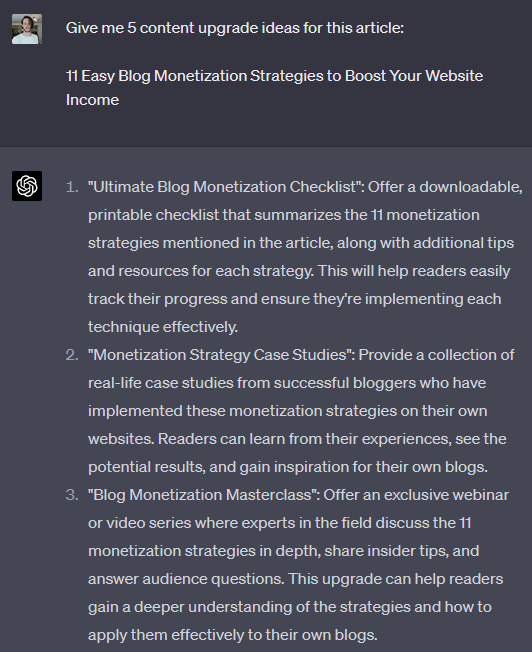
I quite like the Ultimate Blog Monetization Checklist idea because it would be quite easy to make.
In fact, I got ChatGPT to do it for me. Here’s what I asked.
Turn this article into “The Ultimate Blog Monetization Checklist” that can be used as a content upgrade:

I pasted the entire blog post after the prompt, and here’s a glimpse of the results:
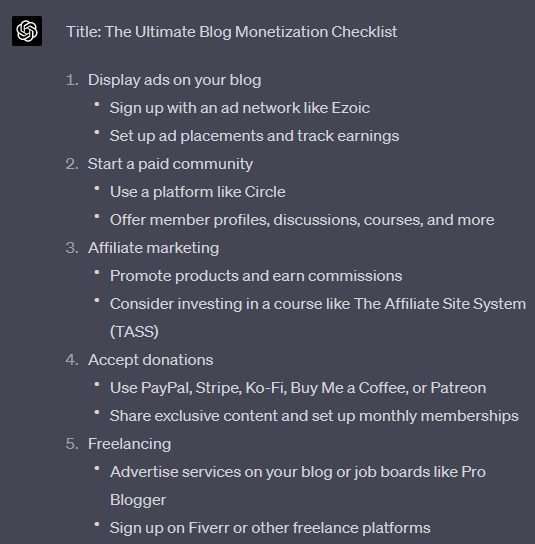
Now we need some enticing copy to get people to opt-in. Here’s the prompt I used:
Write short and punchy opt-in form copy for this content upgrade using the AIDA formula
And here’s the result:
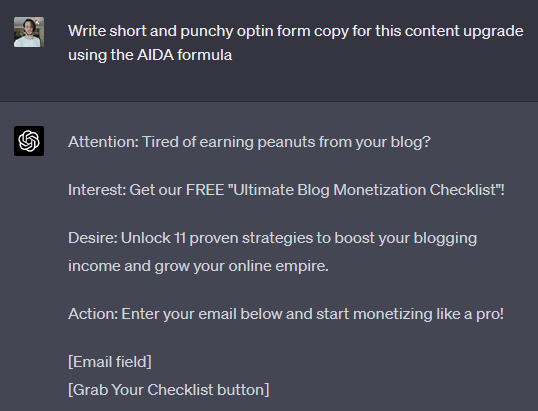
4. Match Audience Archetypes
Writing in the style of an archetype that matches your brand and audience is a powerful way to connect with the reader.
Archetypes are universal characters that mirror human traits, values, and motivations.
For example, Tony Stark is the perfect image of the Creator archetype, which portrays innovation, creativity, and ambition.
To update your content to match your preferred archetype, try this ChatGPT prompt, followed by the text:
Rewrite this text in the style of the Creator Archetype, whilst keeping the details and context intact:
Here’s the before from my post, How to be successful at blogging:
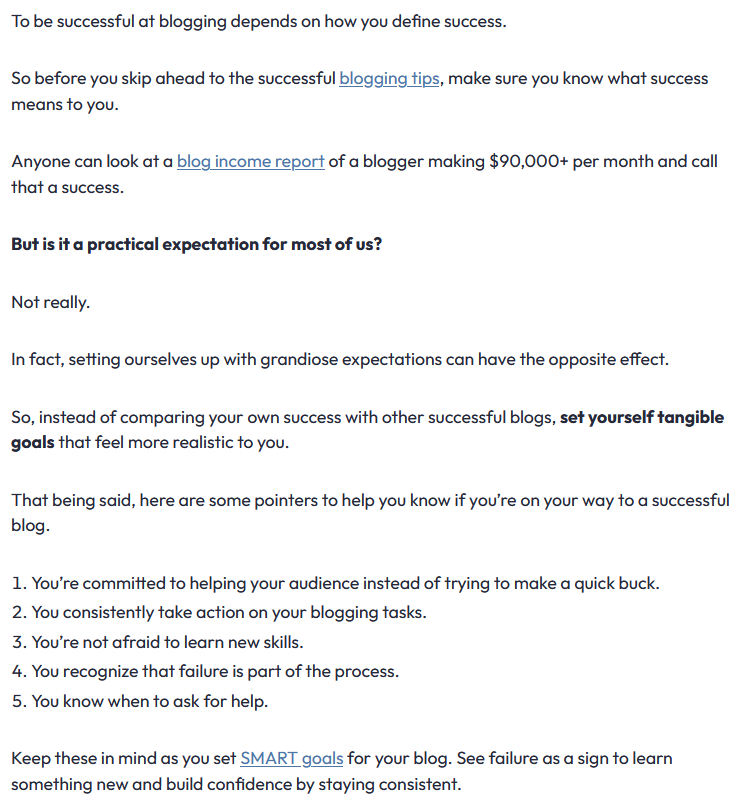
And here’s the updated ChatGPT version:

5. Increase Income
The last tip to achieve higher conversions is to promote a product or service after your introduction.
But what should you promote?
Simply ask ChatGPT with this prompt followed by your intro:
Analyze this text and recommend a product or service I could promote for affiliate commissions:
Here are my results for the article Best Skill to Learn to Make Money:
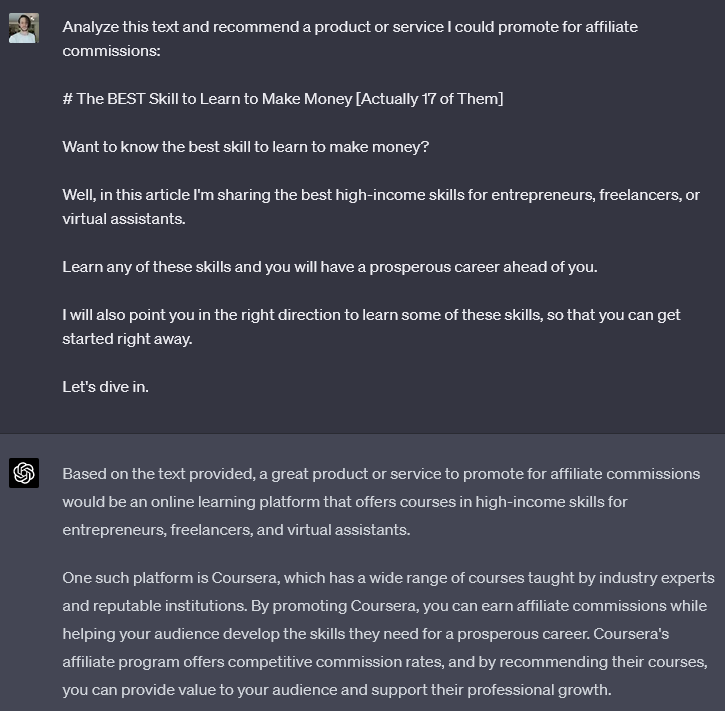
Enhance Content Engagement
Quality content can be summarized by how engaging it is.
When the reader wants to keep reading, it means you’re doing a good job. And your conversions will reflect this.
You can do this by adding bucket brigades and bullet points and using more compelling subheadings.
Here’s how to simplify the process using ChatGPT.
6. Make Subheading More Appealing
An effective way to increase content engagement is to make the subheadings more interesting.
To do this with the article you want to update, copy and paste all the subheadings into ChatGPT followed by this prompt:
Update this outline to make each subheading more engaging
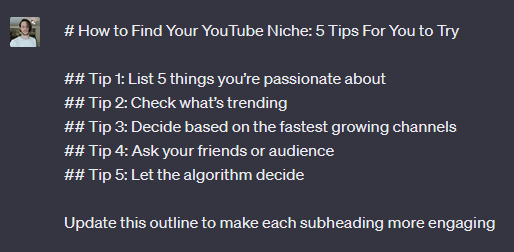
The results I got were very cool, even if the formatting was a little off:

7. Add Bullet Points
Bullet points are fantastic at highlighting the value and slowing down skimmers.
Adding bullet points to your content can have a positive impact on engagement and time on site.
Here’s a ChatGPT prompt for baking them into your articles:
Add value-driven bullet points to this text where it makes sense:
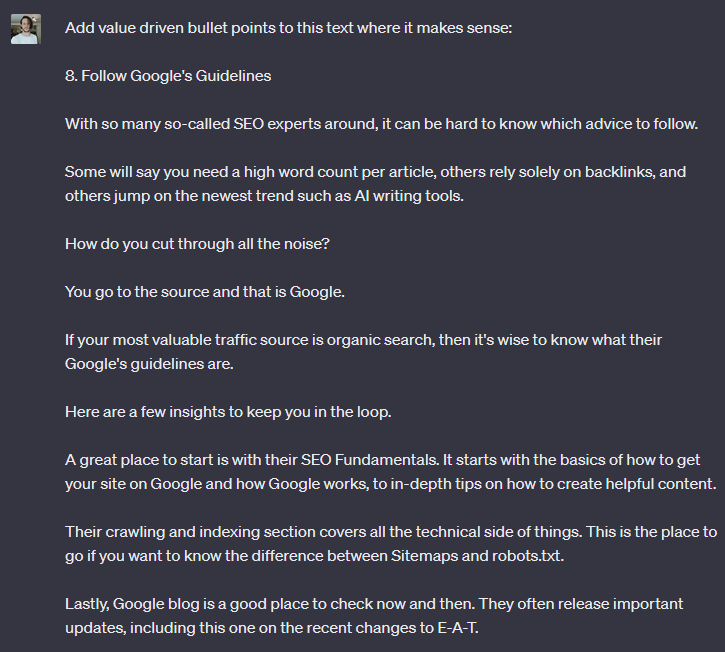
This text was taken from a blogging tips post I wrote a while back.
And here is ChatGPT’s output:

It kept all the text intact but added bullet points to make the content stand out.
8. Utilizing Bucket Brigades
Bucket brigades, also known as grease slides, are short phrases used to keep people reading your content for longer.
They are similar to transitions but pack more of a punch and cultivate curiosity.
Let’s see if ChatGPT can improve this text with some bucket brigades.

Here’s the prompt:
Add bucket brigades to this text to keep people reading for longer. You can change up the text to make it blend in with the bucket brigades, but keep the context intact:
And the results?
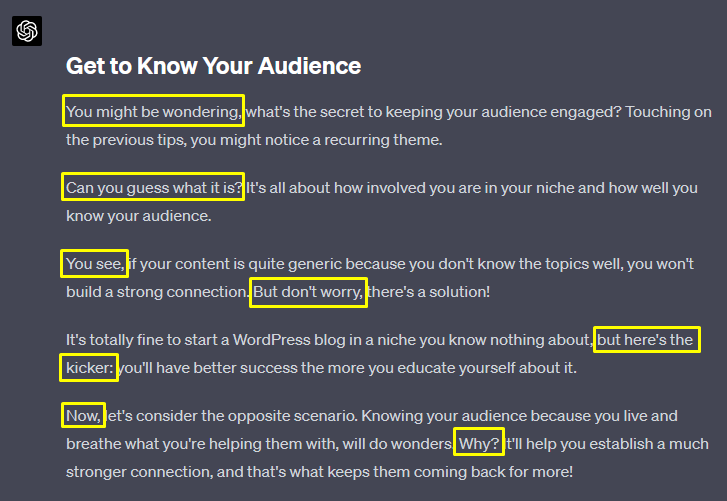
I must say, I’m impressed with some of these. It flows well and makes the whole thing more engaging.
Try it yourself.
9. Restructuring for Readability
Readability is all about the way you construct sentences together. It needs to be done in a conversational way that is easy to read.
The average reading level is grade 8, so anything higher than this can put off some of your readers.
Take a look at this text in the Hemingway Editor:

Let’s see if ChatGPT can make it a lot easier to read.
Here’s the prompt I used, followed by the text:
Rewrite this text, but with a Flesch Reading Ease of less than 80:
And the results are on point:

Generating New Insights and Ideas
Another way to use ChatGPT for updating content is to find missing information and other resources to add more value.
Here are a few ways to do this.
10. Identifying Content Gaps
Content gaps are the missing topics that help a person get from where they are to where they want to be.
If your content doesn’t go deep enough, they’ll need to find the information elsewhere.
To find content gaps in your articles, use a prompt like this one and feed ChatGPT your entire post:
Analyze this text and suggest anything missing, new ideas, and content gaps, that would add more value to the overall content:
Like this:
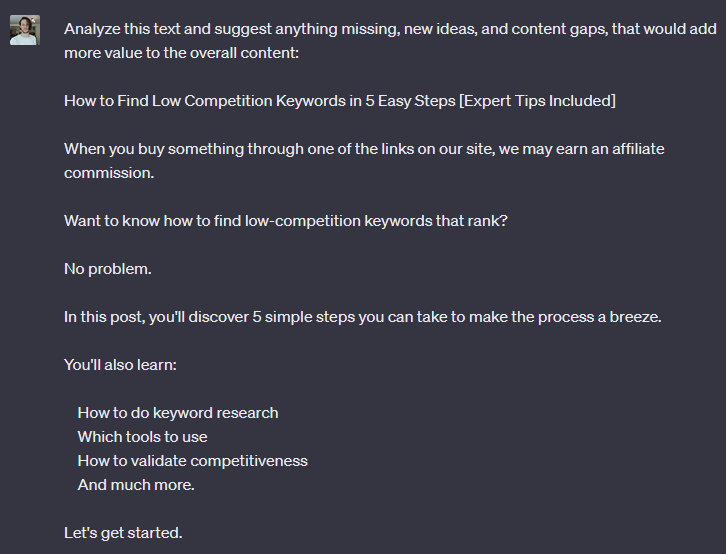
And here are some of the suggestions:

11. Relevant Book Recommendation
Recommending relevant books in your content is a great way to provide readers with further reading.
Staying in the same chat screen as the previous tip, ask this prompt to get a book recommendation:
What is a good book on this topic that I could reference within the text?

12. Expert Opinions and Quotes
Expert opinions help provide credibility to your content and build trust with the audience.
You can also add a quote to provide context.
For example, here’s a relevant quote from the founder of ChatGPT, taken from his Startup Playbook:
To have a successful startup, you need: a great idea (including a great market), a great team, a great product, and great execution.
Sam Altman
This prompt will help you uncover this valuable information:
Name 3 experts related to this text and provide me with a contextually relevant quote from each of them.
Here are the results given for a post titled Profitable Ways to Make Money with Machine Learning:

Optimizing for SEO
Another way to use ChatGPT for updating content is to improve SEO.
Doing the following will help you find missing content, adds relevant keywords, and creates internal linking opportunities.
13. Content Comparison and Analysis
Google’s helpful content update emphasizes the importance of people-first content. Therefore, quality content that is helpful and thorough will have a better chance of ranking well.
You can achieve such results by finding out which information is missing from your content and bridging the gaps.
This also helps to include relevant data that Google correlates with the top-performing posts.
Here’s how to use ChatGPT for this.
First, get a list of the top-ranking articles for your primary keyword, then scrape the outlines for each of them using the Detailed Chrome extension.

Use these prompts to get Chat GPT to compare these outlines with your own:
I will provide you with some text and I want you to wait for my next instructions

Then, paste in all the outlines you gathered from the top 5 search results.

Next, use this prompt, followed by the outline of your article.
Analyze the text and compare it to this text below. Give me a list of what is missing, so that I can optimize it for SEO:
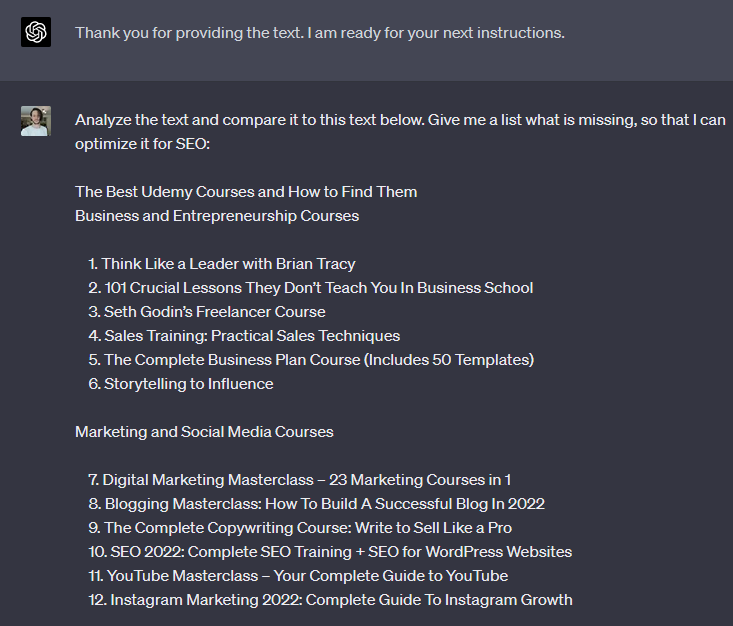
ChatGPT will give you a list of all the topics or sections missing from your article.

Adding these to your outline will improve the overall SEO of the page.
14. Find Internal Linking Opportunities
To build a solid foundation for SEO, your content creation process should include internal links.
When a related post is linked to others, it establishes topical authority and higher rankings.
Use this prompt followed by the title of your post to find related content:
List 10 semantically relevant article ideas that have a different search intent to this one:
You’ll get back a useful list of highly relevant articles for you to publish.
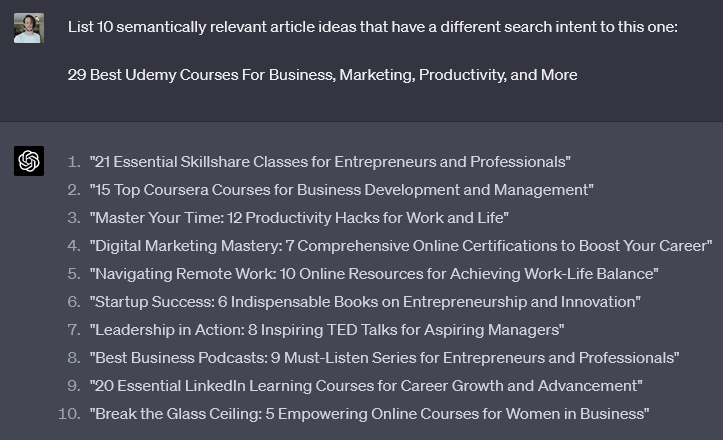
You can then internally link these together to create topical relevance and boost your SEO.
If you want to automate the internal linking process, check out our WordPress plugin LinkWhisper.
15. Integrating Keywords Naturally
This prompt will incorporate a list of semantically relevant keywords into your content.
You can get this list of keywords from a tool like SurferSEO or MarketMuse.
Or try using a free tool from Originality.ai, an artificial intelligence tool that detects AI-generated content.
Then, use this prompt, followed by the list of keywords, then followed by the content:
Incorporate these keywords into the content without changing the context. Only output a list of the sentences where the keywords have been added and the surrounding text:
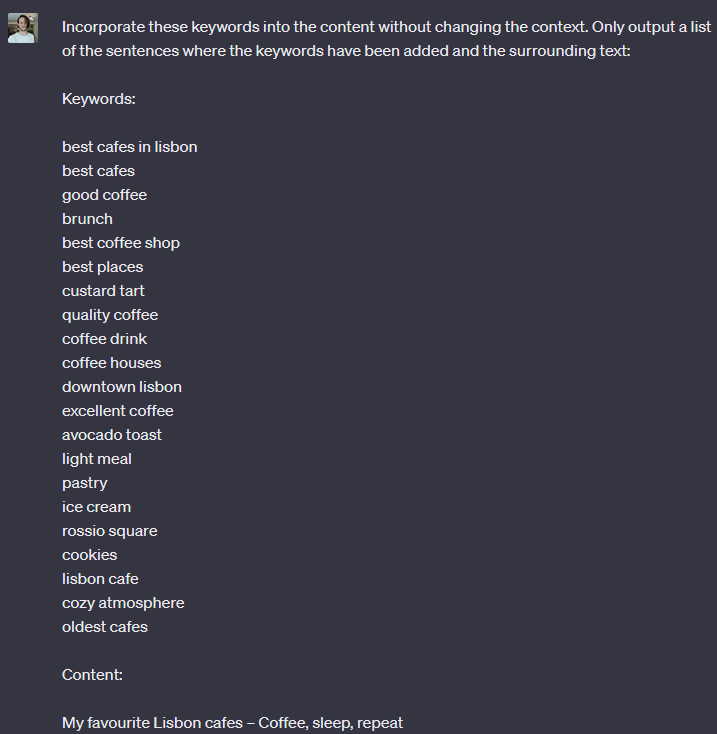
ChatGPT will give you a list of sentences that you can add to the content that include the keywords.
Here’s the score in MarketMuse:

And here’s the score after I added the sentences:

Boost Credibility and Trustworthiness
In this last category, we’ll explore two things you can add to your content to increase credibility and trustworthiness.
16. Data-Driven Content Insights
Providing statistics and trending insights in your content is one way to add more credibility.
Bear in mind that ChatGPT data only goes up to 2021, and it will often get facts and figures completely wrong.
Make sure you fact-check any stats it gives you before adding them to your content.
I used this prompt for the blog post titled, 11 Profitable Ways to Make Money with Machine Learning:
Provide me with a list of data-driven insights, stats, trends, patterns, and important topics related to the given article title:
Here are the results:

17. Storytelling and Narrative Techniques
Adding related stories to your content can have a huge impact on the connection you make with the reader.
These can be sprinkled throughout your articles, but the best place for them is in your intros.
Here’s how it looks for the article, best minimalist WordPress themes.
The original has no storytelling at all:

I used this prompt and added the intro after it:
Rework this intro to include a personal story to better connect with the reader:
And here is the result. Quite impressive:
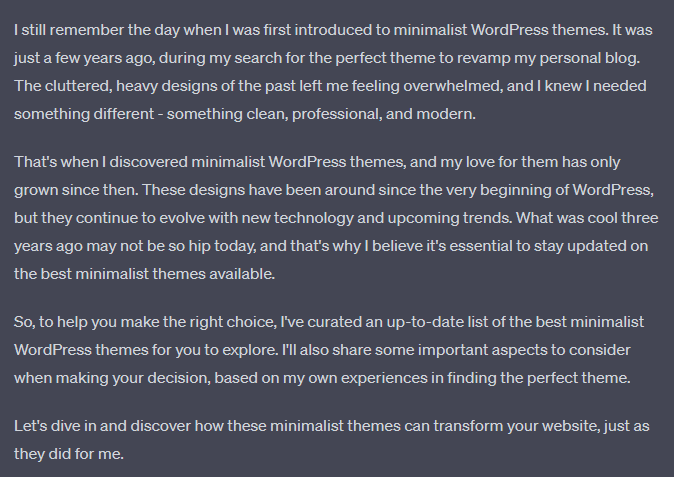
ChatGPT for Updating Content: How to Get the Most from ChatGPT
Here are a few recommendations to get the most out of ChatGPT when updating content.
Upgrade to ChatGPT-4
Many of the examples I shared in these tips were using ChatGPT-3.5, but this language model has its limitations.
ChatGPT-4 produces much better results because it’s a larger AI model. This means it can understand more complex prompts and provide better insights.
If you’re struggling to get good results with 3.5, consider upgrading to ChatGPT Plus.

The Importance of Clear Instructions
The secret to using ChatGPT for updating content is all about using clear instructions, also known as Prompt Engineering.
This is becoming a valuable skill to learn and is essential if you want to get better results.
Try adding as many details to your prompts as possible. The more intricate your prompts are, the more accurate the output will be.
Try this Addon for Unlimited Prompt Ideas
Want an almost unlimited supply of powerful prompts?
Download the Chrome extension AIPRM for ChatGPT to turn ChatGPT into an advanced prompting machine.

You get predefined prompt templates that have been constructed by expert prompt engineers. All you have to do is will in your topic or keyword.
Conclusion: ChatGPT for Updating Content
That concludes this in-depth guide for using Chatgpt for updating content.
Love it or hate it, AI technology for content creation is revolutionizing the industry.
Learning how to use ChatGPT for marketing will drastically improve how well your content performs.
AFFILIATE MARKETING
Samsung: 6-Day Workweek For Execs, Company in Emergency Mode

Four-day workweeks might have all the buzz, but one major tech company is going in the opposite direction.
Samsung is implementing a six-day workweek for all executives after some of the firm’s core businesses delivered lower-than-expected financial results last year.
A Samsung Group executive told a Korean news outlet that “considering that performance of our major units, including Samsung Electronics Co., fell short of expectations in 2023, we are introducing the six-day work week for executives to inject a sense of crisis and make all-out efforts to overcome this crisis.”
Lower performance combined with other economic uncertainties like high borrowing costs have pushed the South Korean company to enter “emergency mode,” per The Korea Economic Daily.
Related: Apple Is No Longer the Top Phonemaker in the World as AI Pressure and Competition Intensifies
Executives at all Samsung Group divisions will be affected, including those in sales and manufacturing, according to the report.
Samsung had its worst financial year in over a decade in 2023, with the Wall Street Journal reporting that net profit fell 73% in Q4. It also lost its top spot on the global smartphone market to Apple in the same quarter, though it reclaimed it this year.
Though employees below the executive level aren’t yet mandated to clock in on weekends, some might follow the unwritten example of their bosses. After all, The Korea Economic Daily reports that executives across some Samsung divisions have been voluntarily working six days a week since January, before the company decided to implement the six-day workweek policy.
Entrepreneur has reached out to Samsung’s U.S. newsroom to ask if this news includes executives situated globally, including in the U.S., or if it only affects employees in Korea. Samsung did not immediately respond.
Research on the relationship between hours worked and output shows that working more does not necessarily increase productivity.
A Stanford project, for example, found that overwork leads to decreased total output. Average productivity decreases due to stress, sleep deprivation, and other factors “to the extent that the additional hours [worked] provide no benefit (and, in fact, are detrimental),” the study said.
Related: Samsung’s Newest Galaxy Gadget Aims ‘To See How Productive You Can Be’
Longer hours can also mean long-term health effects. The World Health Organization found that working more than 55 hours a week decreases life expectancy and increases the risk of stroke by 35%.
The same 55-hour workweek leads to a 17% higher risk of heart disease, per the same study.
AFFILIATE MARKETING
John Deere Hiring CTO ‘Chief Tractor Officer,’ TikTok Creator

This article originally appeared on Business Insider.
Agriculture equipment company John Deere is on the hunt for a different kind of CTO.
The brand on Tuesday announced a two-week search to find a “Chief Tractor Officer” who would create social media content to reach younger consumers.
One winning applicant will receive up to $192,300 to traverse the country over the next several months showcasing the way John Deere products are used by workers, from Yellowstone National Park to Chicago’s Wrigley Field and beyond.
“No matter what you do — whether it’s your coffee, getting dressed in the morning, driving to work, the building you go into — it’s all been touched by a construction worker, a farmer, or a lawn care maintenance group,” Jen Hartmann, John Deere’s global director of strategic public relations, told AdAge.
To kick off the search, John Deere tapped NFL quarterback Brock Purdy (who will presumably be a bit busy this Fall to take the job himself) to star in a clip in which he attempts to set out on a road trip in an industrial tractor.
Suited up in the obligatory vest, work boots, and John Deere hat, Purdy’s progress is interrupted by teammate Colton McKivitz hopping into the cab while a string of messages floods in from other athletes and influencers expressing interest in the job.
The clip also represents the first time that the 187-year-old company has used celebrities to promote itself, Hartmann told AdAge.
According to the contest rules, entrants have until April 29 at midnight to submit a single 60-second video making their pitch for why they should be the face and voice of the company.
In addition, entrants must live in the 48 contiguous states or DC — sorry Hawaii and Alaska residents. Interestingly, any AI-generated submissions are prohibited, too.
Videos will be judged against four categories — originally, creativity, quality, and brand knowledge — after which five finalists will be chosen and notified after May 17.
AFFILIATE MARKETING
How to Capitalize On This Thriving Talent Pool to Drive Your Company’s Growth

Opinions expressed by Entrepreneur contributors are their own.
As business operations shift, executives and entrepreneurs are increasingly turning to an on-demand workforce that is simultaneously empowered by technology and drawn to purpose-driven projects.
Consider Upwork, whose 2020 Future of Workforce Pulse Report revealed that nearly 80% of hiring managers engaging freelancers feel confident about doing so. These hires provide coveted expertise — on a project-to-project basis — that entrepreneurs need to scale their operations without incurring long-term overhead costs.
This new market paradigm also promotes dynamism, with 79% of businesses agreeing that freelance talent enables greater innovativeness. Perhaps most telling, 84% of hiring managers utilizing it feel more assured about adapting to future disruption, compared to just 69% of those relying solely on full-time staff.
By capitalizing on freelance marketplaces, entrepreneurs can amplify employer branding, augment capabilities and future-proof organizations, even amid turbulence. As nearly 60% of hiring managers plan to increase engagement with freelancers over the next two years, the time is now for executives to realize their inherent potential.
Related: Navigating the Great Reshuffle: Why Your Employer Brand is Key in Recruiting Talent
The job market continues to shift
After a season of massive hiring, we’re back to seeing layoffs and downsizing. Companies are feeling the bloat—from unused office spaces with rising rent to oversized employee structures — and are shifting focus to hiring only the most essential positions. This leaves a critical talent gap needed for complex projects and specialized tasks. Highly skilled and specialized independents can fill this void.
A few key benefits to engaging them:
• Access to niche experts: Platforms like Toptal and Guru provide access to elite professionals from leading Fortune 500 companies and innovative startups. Whether the need is for a machine learning specialist, growth strategist or financial modeler, entrepreneurs can now curate on-demand teams that boast specialized skillsets, enabling them to focus investment on projects with the highest strategic value.
• Enhanced agility: Leading corporations increasingly “rent” skills by tapping freelance experts for initiatives involving new technologies or while entering unfamiliar markets. With niche contributors available to plug knowledge gaps, owners can explore ideas that once seemed unrealistic due to internal constraints—unlocking inventiveness and first-mover advantage.
• Stronger employment brand: Blending full-time employees with project-based freelancers signals a commitment to modernization and work-life balance. Offering both engaging work and flexibility will help draw exceptional candidates and help you compete with corporate giants for top-tier talent.
Related: Can Retirees Thrive in the Gig Economy? Navigating a Changed Workforce
Tips for capitalizing on gig talent
Having explored the forces reshaping work, executives may wonder how to effectively leverage freelance platforms. After all, how can you know you’re getting your money’s worth if a hire isn’t physically present full-time?
• Define projects clearly: Contract hires thrive when expectations and deadlines are established upfront. So, clearly, detail needs around deliverables, success metrics, required skills and projected time investments. Staying ahead when it comes to communication and expectations will help avoid headaches, including delays.
• Build loyalty with talent: The best independent professionals have options regarding the projects they accept. Study their profiles to discern passions and incentives. Offer interesting work, flexibility and strong communication to motivate interest and improve results.
• Manage collaboration: Provide steady context, feedback and guidance at each project stage, but also foster autonomy, even while directing efforts toward strategic goals. A dynamic balance of these qualities drives optimal outcomes.
• Continue expanding your talent pool: Add proven freelancers to an internal database for repeat engagements, and notify talent about new initiatives for which their expertise would provide an edge. Uncovering additional ways, freelancers can enhance the business deepens the relationship.
Related: Fill Your Talent Gap by Sourcing Candidates From the Veteran Community
Top platforms for connecting with talent
Now comes the hard part: finding contractors who bring fractional expertise sets. There are a growing number of platforms, of course, but I’ve found that the following stand out as leaders:
Fiverr: Ideal for execs seeking design, digital marketing, writing, video and admin support. Known for affordability and ease of posting jobs. It taps a global talent pool, too.
Upwork: A flexible platform that spans more than 150 skills. Used by everyone from small businesses to global enterprises. Strong at IT, development, design, finance and consulting.
Toptal: Focuses exclusively on the top 3% of talent. Best for expert software developers, designers, project managers and finance experts. All contributors are extensively vetted.
Contra: A growing independent platform that vets and connects both job candidates and hiring companies. Best of all, it doesn’t take a commission from projects.
Related: 3 Strategies to Optimize Your Hiring Process and Find the Best Employees
The numbers speak for themselves: businesses engaging freelance professionals report greater confidence and competitiveness, as well as the ability to withstand turbulence, yet legacy beliefs can still cause hesitancy among those keen to hire. Supported by such specialized collaborators, companies can explore new horizons unencumbered by a one-time narrow view of staffing models.
-

 MARKETING7 days ago
MARKETING7 days agoRoundel Media Studio: What to Expect From Target’s New Self-Service Platform
-

 SEO6 days ago
SEO6 days agoGoogle Limits News Links In California Over Proposed ‘Link Tax’ Law
-
SEARCHENGINES6 days ago
Daily Search Forum Recap: April 12, 2024
-

 SEO5 days ago
SEO5 days ago10 Paid Search & PPC Planning Best Practices
-

 SEARCHENGINES5 days ago
SEARCHENGINES5 days agoGoogle Core Update Volatility, Helpful Content Update Gone, Dangerous Google Search Results & Google Ads Confusion
-

 MARKETING6 days ago
MARKETING6 days ago2 Ways to Take Back the Power in Your Business: Part 2
-

 MARKETING4 days ago
MARKETING4 days ago5 Psychological Tactics to Write Better Emails
-

 SEARCHENGINES4 days ago
SEARCHENGINES4 days agoWeekend Google Core Ranking Volatility














